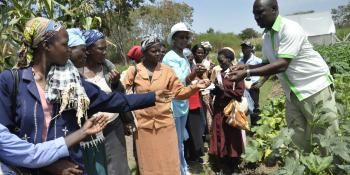Searching for better bean varieties in Uganda

Researchers are working on implementing a participatory action research project linked to more drought tolerant bean varieties in Uganda. Seeing as the country is a net exporter of beans, this project might help farmers get better armed to adapt to the immediate effects of climate variability.
The common bean, also known as Phaseolus vulgaris L in latin, is widely grown in Uganda as a major food and cash crop. It is sensitive to climate change and variability, and therefore serves as a good entry point to evaluate adaptability to climate change and variability amongst the crops grown by farmers.
Ongoing since 2012, the project is being implemented in Hoima and Rakai, the CGIAR Research Program on Climate Change, Agriculture and Food Security (CCAFS) learning sites in Uganda. Both Hoima and Rakai are characterised by significant weather variability, highly degraded landscapes, decreasing soil fertility and increasing soil erosion that is already impacting negatively on crop and livestock production. Hoima is showing trends of becoming wetter while Rakai is getting drier as a result of climatic changes.
The research project is being coordinated and carried out by the National Agricultural Crop Research Resources Institute (NaCRRI)-bean program and the International Centre for Tropical Agriculture (CIAT) under the Pan Africa Bean Research Alliance (PABRA) alliance.
Learn more: Case studies: Crop adaptation to climate change - Beans
Involving farmers in research is a key component to adaptation
The research design was motivated by the understanding that social learning between researchers and farmers is central to changing attitudes, actions and processes needed to adapt to climate change.
Both farmers and researchers do have knowledge and technologies that can be shared, integrated and promoted when addressing climate change and variability.
What is social learning? Making it real: Social learning in practice
The project was initiated in March last year with nine farmer groups comprising of both men and women members from our climate smart villages in Uganda.
In the first phase, field trials took place with the idea to evaluate performance of four drought tolerant bean varieties that farmers used and really liked. The drought tolerant beans came from the Kenya Agricultural Research Institute (KARI).
In the field trial, one released bean variety (NABE 15) and one farmer variety, were set up.
Sessions where farmers could feed in their experiences and discuss the beans and their performances were set up. In the end, more than 300 farmers engaged in discussions to identify their preferred beans and the different trade-offs between the varieties.
According to Enid Katungi, a bean researcher from CIAT:
“the first phase of the participatory sessions provided lessons on the realities of climate variability, diversity of the microenvironments, farmer preferences and constraints. These lessons formed the basis of modifying the trial varieties as well as methodology of the trials that followed in March, 2013”.
As a result from the discussions, the number and diversity increased to 15 bean varieties of varying market classes and traits; drought tolerance, disease resistance, micro nutrient rich, and local adaptation.

Which bean is the best? A number of bean trials were recently held with the help and support from farmers in Uganda. Photo: N. Palmer
Learn more about bean-breeding: Breeding climate-proof beans to protect the "Poor Man's Protein"
The bean varieties evaluated included, six released bean varieties (one of which is a universal susceptible check), seven regional varieties, one local land race and one farmer grown variety.
Replicated trials were set up in the same villages among the two districts using a mother baby trial design. In total, nine mother trials and 45 baby trials were established.
An element of fertiliser application was included in the mother gardens with DAP being applied in some plots and not in others. Soil analysis revealed that the soils in most of the sites were sandy clay loam soil, or clay loam to loamy soils and sandy clay soil. Phosphorous levels in all the sites was below the critical levels while, Nitrogen levels in most of the sites was sufficient.
Farmers and researchers work together to evaluate bean varieties
The importance of diversity in adaption to climate change was obvious in the results for trial two. The weather turned out to be drier in all sites affecting most bean varieties.
There were significant differences in the performance of the varieties among the environments, providing more lessons to consider in the next action. In particular, all the 15 varieties had at least one characteristic that attracted some farmers with varying levels of preference.
Individual based interviews with farmers participating in the baby trials confirmed that variety attributes in high demand were yield, marketability and early maturity. Other important traits included drought tolerance, taste, cooking and uniformity in maturity.
The results highlight positive benefits of participatory action research. The “test varieties” significantly outperformed the local varieties. From this project, the researchers are learning that making blanket variety and management recommendations to cover large physical areas e.g., the whole country is wrong.
Site and context specific recommendations, especially, in the view of the climate and soil variability being observed is probably the best option.
The need for plasticity in bean varieties (ability to change structure and function when exposed to changes in the environments hence suitability to a wide range of environments) was also highlighted.
This story was written with input from Claire Mukankusi and Enid Katungi from CIAT-PABRA, Gabriel Luyima and Stanley Nkalubo from National Crops Resources Research Institute (NaCCRI) and Bruno Awio, from Makere University all researchers involved in the study



